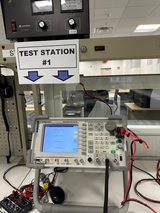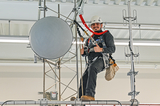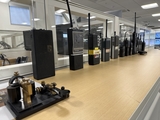Redwood City – It all starts with the humble radio.
When we think about wireless communication, minds tend to jump to digital data bursts (6G is coming) and internet connections beamed from space.
But for first responders, park rangers, public works crews and others across County departments, the two-way, push-to-talk radio — which is, in fact, far from humble — is the go-to gadget for critical real-time communication that can often save lives.
This week, the communications specialists who keep the County’s radio systems running — often in the background and without recognition — moved into a modern, spacious Radio Shop in Redwood City after years without a permanent home. It’s now the go-to place to repair, to learn, to monitor outages, to coordinate repairs and sometimes even to tinker.

“These are the people getting up in the middle of the night to make sure all of those emergency systems are functioning,” said Natasha Claire-Espino, director of the County’s Public Safety Communications, whose dispatchers handle 911 calls. “Without the Radio Shop, without the radios, we would not be able to dispatch our public safety agency partners to every-day emergencies.”
Spread over 13,000 square feet, the new Radio Shop includes a service garage to work on vehicles, parking for SUV-sized emergency generators and a latticework of bars and poles that allow technicians to practice scaling towers while weighed down with harnesses and gear.
Upstairs, testing equipment spreads across rows of stand-up repair stations. Large video display screens help technicians monitor the health of a complex network of microwave transmitters, antennas, relay stations, communications towers, site electrical power status and redundant systems that reach from Daly City to past Pescadero.
In total, the Radio Shop serves approximately 2,300 radios, plus the infrastructure that supports those radios.

“It’s like operating a telecommunications company but instead of covering nationwide we’re covering countywide,” said Payman Maghami, a senior systems engineer with the County’s Information Services Department, which runs the Radio Shop. “We have extremely high reliability and multiple redundancies built in.”
Among the County agencies that rely on the Radio Shop and the network it maintains are the Sheriff’s Office, Parks Department, Public Works Department, Department of Emergency Management, Probation Department, County Health, Human Services Agency and building inspectors.
That’s just the start. Other agencies that rely on the network include the Peninsula Human Society, American Medical Response (the County’s ambulance provider), SamTrans and various public safety departments.
“Having been on the other side of that radio during a pursuit, I can tell you how important it is that it works all the time,” said Mike Callagy, now the County’s executive officer and a former police officer, said during a tour and ribbon cutting.
“This is really about the support they provide and really the thousands of people out there who rely on the infrastructure of the radio system,” Callagy said.
Supervisor David J. Canepa said the Radio Shop is the result of the County making investments “not just in 21st Century technology but 22nd Century technology.”
“Thank you to everyone,” Canepa said, “who has had the ability to work on the project. We appreciate all of the effort.”

Michelle Durand
Chief Communications Officer
mdurand@smcgov.org
